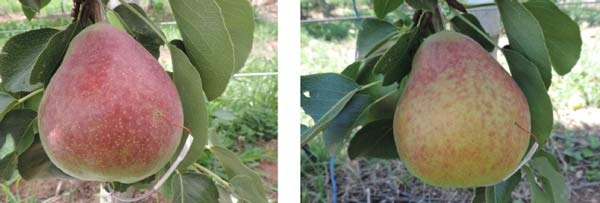Effects of temperature (continued from last issue)
Typically low temperatures induce red development in many fruit types while high temperatures are generally associated with poor red colour development.
For apples, red colour development in all cultivars seems to require or benefit from low temperatures but not all red and blush pear cultivars respond to low temperatures.
Blush pear cultivar Rosemarie grown in South Africa, required low temperatures for anthocyanin synthesis but the effect of cold temperature was much greater during early fruit development than in the week before harvest (Steyn et al. 2004a, Steyn et al. 2004b).
Furthermore, Rosemarie pears lost red colour rapidly during intermittent hotter periods due to reduced anthocyanin synthesis and increased anthocyanin degradation, resulting in a net degradation of colour during pre-harvest growth and development.
Compared to Rosemarie, colour development of Bon Rouge, Flamingo and Forelle is more stable and less responsive to temperature (Steyn et al. 2004b).
It is not clear whether this red colour stability is caused by less degradation or as is suggested by Steyn et al. (2004b), a continuation of anthocyanin synthesis regardless of high temperature.
Little is known about the behaviour of colour development in the red and blush pear cultivars grown in Australia.
Effects of light
While light is critical for promoting red colour development, the high levels of solar radiation that can be experienced in Australian orchards over summer can increase skin temperature to the point where anthocyanin synthesis may be inhibited and active degradation or fading of existing colour begins (see Figure 1).
Research in South Africa shows that before harvest, the contribution of radiation induced anthocyanin degradation to skin colour increases as the ability of pear fruit to accumulate anthocyanin decreases and this varies with different pear cultivars (Steyn et al. 2005).
Conclusion
In conclusion, high levels of solar radiation stimulate anthocyanin synthesis in cool conditions but anthocyanin degradation may occur simultaneously when skin temperature increases, as may happen under Australian conditions.
Whether the result is a colour gain or colour loss depends on many factors which are not well understood in Australia.
They include cultivar, level of temperature and exposure time. All these factors require further investigation under Australian conditions to more fully determine the dynamics of colour development in red and blush pear cultivars.
References
Steyn WJ, Holcroft DM, Wand JE, Jacobs G (2004a) Regulation of pear color development in relation to activity of flavonoid enzymes. J Amer Soc Hort Sci. 129(1): 6-12.
Steyn WJ, Holcroft DM, Wand JE, Jacobs G (2004b) Anthocyanin degradation in detached pome fruit with reference to preharvest red color loss and pigmentation patterns of blushed and fully red pears. J Amer Soc Hort Sci. 129(1):13-19.
Steyn WJ, Wand SJE, Holcroft DM, Jacobs G (2005) Red colour development and loss in pears. Proc. IXth IS on Pear Ed.: K.I. Theron, Acta Hort. 671, ISHS 2005, pages 70-85.
van den Ende B (2011) Grow perfect Forelle pears on Tatura. Good fruit Grower Sept 1, 2011. http://www.goodfruit.com/grow-perfect-forelle-pears-on-tatura/
See this article in Tree Fruit Dec 2015






















